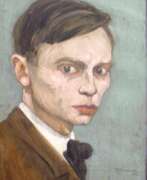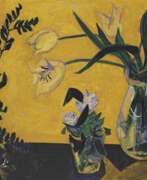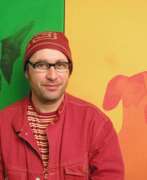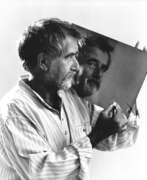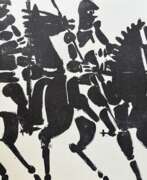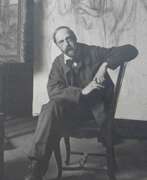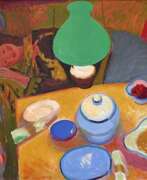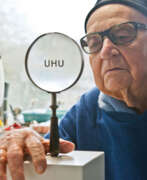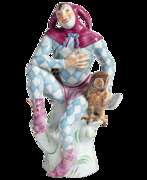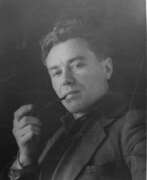Graphic artists Animalistic


Helmuth Macke was a German painter of the first half of the twentieth century. He is known as a painter and graphic artist, landscape painter, genre painter and portraitist.
Helmuth Macke is considered a representative of Rhenish Expressionism. His work merged influences of constructivism, abstractionism and other artistic movements. At the end of his career he created the "Blue Room" for the industrialist Karl Gröppel in Krefeld; it was discovered after decades of neglect in 2012 and now adorns the Krefeld Villa Goecke after restoration.
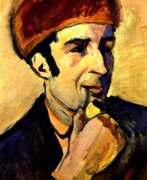

Franz Moritz Wilhelm Marc, a pivotal figure in German Expressionism, remains celebrated for his innovative contributions to 20th-century art. Born in Munich, Bavaria, within the German Empire on February 8, 1880, Marc's journey into the art world was profoundly influenced by his education at the Academy of Fine Arts in Munich. His distinct artistic vision is most famously encapsulated in works like "The Tower of Blue Horses", "Yellow Cow", and "Blue Horse I", each radiating with vibrant colors and emotional depth. Marc's affiliation with Der Blaue Reiter, a journal he co-founded, underscored his role in the German Expressionist movement, emphasizing the spiritual and symbolic significance of color in art.
Marc's oeuvre predominantly features animals, presented not merely as subjects but as embodiments of primal purity and emotional resonance. This choice of subject matter, combined with a stark, almost cubist portrayal, allowed Marc to explore themes of spirituality, masculinity (often symbolized by blue), and the tumultuous essence of life itself. His work "Fate of the Animals", which hangs in the Kunstmuseum Basel, exemplifies this thematic exploration, portraying a premonition of chaos and destruction that eerily anticipated the outbreak of World War I.
Tragically, Marc's promising career was cut short by his death at the Battle of Verdun on March 4, 1916, during World War I, where he served in the German Army. Despite his premature demise, Marc's legacy endures through his profound impact on modern art, as seen in his vibrant compositions that continue to captivate audiences in galleries and museums worldwide. His artworks, once labeled as "degenerate" by the Nazis, have transcended this vilification, achieving acclaim and fetching high sums at auction, with "Die Füchse (The Foxes)" reaching a record £42,654,500.
For collectors and experts in art and antiques, Marc's work represents not only a high point in German Expressionism but also a window into the artist's profound belief in the spiritual power of color and form. His legacy is a testament to the enduring allure and significance of early 20th-century modern art. To stay updated on sales and auction events related to Franz Marc's work, signing up for updates offers a direct link to the vibrant legacy of this remarkable artist.


Arvid Mather was a German impressionist and modernist painter, illustrator, and graphic artist.
He studied painting at the Düsseldorf Academy and belonged to Heinrich Nauen's circle. Mather participated in the exhibitions of Junges Rheinland as well as in the Rheinische Secession.
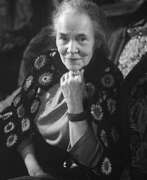

Tatyana Alekseevna Mavrina (Russian: Татьяна Алексеевна Маврина) was a Soviet and Russian artist of the twentieth century. She is known as a painter, graphic artist and illustrator of children's books. Mavrina worked in the genres of portrait, landscape and still life in a style close to primitivism. She boldly experimented with watercolor, gouache and easel graphics.
Tatyana Mavrina is also known as a researcher of folklore. She traveled extensively to distant cities, got acquainted with folk art, made sketches of old architecture. By the drawings of Mavrina later researchers studied the life of the Russian provinces.
For her contribution to the illustration of children's books Mavrina was awarded the State Prize of the USSR, as well as the international literary prize named after HK Andersen. Mavrina's works, as well as her collection of handicrafts are kept in the Russian Museum and the Pushkin Museum.
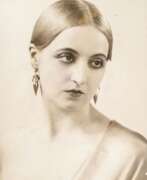

Eileen Rosemary Mayo was an English artist and designer who worked in England, Australia and New Zealand in almost every available medium — drawings, woodcuts, lithographs on stone and tempera, tapestry and silk screening. In addition to being a printmaker, illustrator, calligrapher and muralist, she designed coins, stamps, tapestry and posters, and wrote and illustrated eight books on natural science.




Hans Meid was a German painter, graphic artist and illustrator.
Meid attended an art and craft school in Karlsruhe, and then at the art academy he became a pupil of impressionist Wilhelm Trübner (1851-1917) and realist Walter Kontz (1872-1947). In 1907 the Meissen porcelain manufactory engaged him as a designer; in 1908 he settled in Berlin as a freelance artist. His success was recognized with the Villa Romana Prize (1910) and membership in the Berlin Secession (1911). In 1919 Meid became a lecturer in printmaking at the University of Fine Arts in Berlin. In 1927 he was elected a full member of the Prussian Academy of Fine Arts, where he also headed the graphic arts workshop.
In the first decades of the twentieth century Hans Meid, together with his close friend Max Slevogt, was one of the leaders of Impressionism. He created an extensive collection of etchings, lithographs and engravings, a large number of illustrations for works of world literature, including Cervantes' Don Quixote, Goethe's Selective Affinity and many others. He designed book covers for 44 publishers (notably Schünemann and S. Fischer). He later added ink drawing, watercolor and oil painting. In 1948 Hans Meid became a lecturer at the State Academy of Fine Arts in Stuttgart, he was also a member of the German Artists' Association.
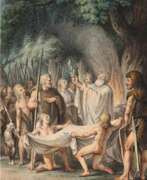

Johann Michael Mettenleiter was a German artist, born in 1765, who left an indelible mark in the fields of drawing, etching, copper engraving, and lithography. His dedication to art was not just confined to creating works but also extended to establishing a lithographic institution and field printing office for the Russian Tsar Alexander I in Warsaw in 1818, a feat that earned him the prestigious Saint Stanislaus Order.
In 1824, Johann Michael Mettenleiter's contributions to art were further recognized when he was honored as an honorary member of the Royal Bavarian Academy of Fine Arts. Despite a severe accident in 1844, his influence continued until his death in 1853 in Passau. His legacy is carried on through his pupils, including his stepsons and his nephew, Johann Evangelist Mettenleiter.
One of Johann Michael Mettenleiter's notable works, "Ariovistus in confrontatie met Caesar, 58 v.C.," created in 1808, captures a historical scene with precision and is housed in the Rijksmuseum. His artworks, like this one, offer a glimpse into the depth and diversity of his skills, showcasing his mastery in capturing historical narratives through art.
For art collectors and enthusiasts, Johann Michael Mettenleiter's works represent a fascinating blend of historical storytelling and artistic prowess. His pieces, whether in private collections or public museums, continue to inspire and captivate audiences, underscoring the timeless appeal of his artistry.
If Johann Michael Mettenleiter's fusion of history and art intrigues you, sign up for updates and stay informed about upcoming sales, exhibitions, and auctions featuring his works. Delve deeper into the world of a visionary artist who bridged the gap between the past and the present through his captivating creations.


Paul Friedrich Meyerheim was a German painter and graphic artist, student of his father Eduard Meyerheim. At the beginning of his artistic career, Paul Meyerheim went to Paris and Barbizon several times to perfect his landscape painting. His special talent lay in depicting animals. He also made a name for himself as a portraitist and was successful as an illustrator with his woodcuts and lithographs.
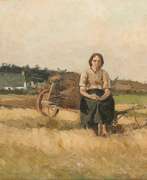

Isidore Meyers is a Belgian landscape painter and draftsman. Around 1850 he studied at the Academy of Fine Arts in Antwerp with Jacob Jacobs. In Paris, where he studied at the École des Beaux-Arts, between 1855 and 1858 Meyers became acquainted with the French painters of the Barbizon school, which opposed formal academicism in landscape painting. In 1858, after returning to Brussels, he began to study in Campina, from where he graduated in October 1861. The Kalmpthout school was born there. In 1865 he became a professor at the Dendermonde Academy, famous for its harmonies of gray tones.
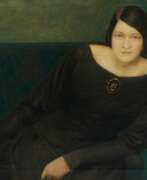

Gabrielle Montald (Canivet) is a Belgian painter. Nothing is known of the artistic training of Canivet, obviously a self-taught artist. On August 9, 1892, Canivet married Constant Montald in Ghent. At that time, Montald was already a renowned painter who won several prizes with his canvases and murals. Unlike Montald, Canivet painted on silk and exhibited only briefly, between 1906 and 1934. Her presence in the art world was rather limited and she was invariably linked to her husband. Canivet knew different materials and techniques such as textiles, pencil, book binding and painting on silk and ceramics. She is known for her paintings on fabric, which she transforms into clothing accessories, but at the same time she also paints porcelain dishes. Mainly during the First World War, she worked on a series of ornamental fish, mushrooms and birds on silk, according to a process known only to her and which allows the fabric to retain all its flexibility. His compositions often include exotic flowers and a snail, which is almost his signature. Symbolism and Art Nouveau, which reached their peak at the end of the century, had a major influence on the conception of his work. His style therefore presents similarities with the idealistic aspirations of the art of the time.
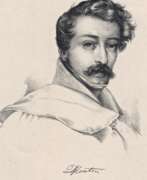

Dietrich Heinrich Maria Monten was a German painter and lithographer.
Dietrich studied painting at the Düsseldorf Art Academy and the Academy of Fine Arts in Munich. He mastered various techniques and took on any genre, but his main subjects were historical, battle and genre themes. He created many large-scale works on important historical events. During his lifetime, Dietrich Monten, together with his colleague Heinrich Ambros Eckert (1807-1840) and others, published more than 1,000 illustrations of the uniforms of European armies in the form of color lithographs collected in separate volumes.
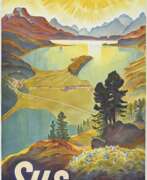

Carl Moos, otherwise Karl Franz Moos was a German and Swiss artist and illustrator, notable for his Art Deco travel and sporting posters, particularly of skiing. He trained in commercial art in Munich and worked as an illustrator for, among others, the Münchener Tagespresse. He also established himself as a creator of postcards and posters. He was a member of the Munich commercial artists' group Die Sechs, which aimed to improve the standing of advertising and poster graphics. His posters are highly sought after in the art market.
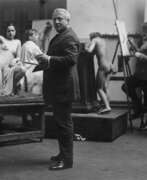

Richard Müller was a German painter and graphic artist. His artistic talent was evident early on. In 1893 he became self-employed as a painter in Dresden. In the fall of 1894, Müller exhibited landscape and animal studies for the first time in the Ernst Arnold Art Salon. In 1895 he met Max Klinger, who encouraged him to study etching techniques. In 1896 he was represented by Arnold at the exhibition "Hand Drawings of German Artists" and won the Grand Rome Prize of the Prussian Academy of Arts, endowed with 6000 gold marks, for his etching "Adam and Eve". In 1900 he received a professorship at the academy, meanwhile as well known in Dresden as Klinger. Müller was highly valued as a painter during the National Socialist era.
